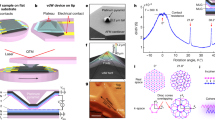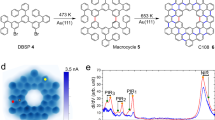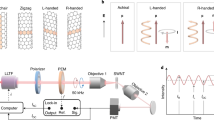Abstract
The drive towards the development of molecular electronics is placing increasing demands on the level of control that must be exerted on the electronic structure of materials. Proposed device architectures ultimately rely on tuning the interactions between individual electronic states, which amounts to controlling the detailed spatial structure of the electronic wavefunctions in the constituent molecules1,2. Few experimental tools are available to probe this spatial structure directly, and the shapes of molecular wavefunctions are usually only known from theoretical investigations. Here we present scanning tunnelling spectroscopy measurements of the two-dimensional structure of individual wavefunctions in metallic single-walled carbon nanotubes; these measurements reveal spatial patterns that can be directly understood from the electronic structure of a single graphite sheet, and which represent an elegant illustration of Bloch's theorem3 at the level of individual wavefunctions. We also observe energy-dependent interference patterns in the wavefunctions and exploit these to directly measure the linear electronic dispersion relation of the metallic single-walled carbon nanotube.
This is a preview of subscription content, access via your institution
Access options
Subscribe to this journal
Receive 51 print issues and online access
$199.00 per year
only $3.90 per issue
Buy this article
- Purchase on Springer Link
- Instant access to full article PDF
Prices may be subject to local taxes which are calculated during checkout



Similar content being viewed by others
References
Aviram, A. & Ratner, M. Molecular rectifiers. Chem. Phys. Lett. 29, 277–283 (1974).
Joachim, C., Gimzewski, J. K. & Aviram, A. Electronics using hybrid-molecular and mono-molecular devices. Nature 408, 541–548 (2000).
Bloch, F. Über die quantenmechanik der elektronen in kristallgittern. Z. Phys. 52, 555–600 (1928).
Wildöer, J. W. G., Venema, L. C., Rinzler, A. G., Smalley, R. E. & Dekker, C. Electronic structure of atomically resolved carbon nanotubes. Nature 391, 59–62 (1998).
Bronikowski, M. J., Willis, P. A., Colbert, D. T., Smith, K. A. & Smalley, R. E. Gas-phase production of carbon single-walled nanotubes from carbon monoxide via the HiPco process: a parametric study. J. Vac. Sci. Technol. A 19, 1800–1805 (2001).
Venema, L. C. et al. Length control of individual carbon nanotubes by nanostructuring with a scanning tunneling microscope. Appl. Phys. Lett. 71, 2629–2631 (1997).
Tersoff, J. & Hamann, D. R. Theory of the scanning tunneling microscope. Phys. Rev. B 31, 805–813 (1985).
Rubio, A., Sánchez-Portal, D., Artocho, E., Ordejón, P. & Soler, J. M. Electronic states in a finite carbon nanotube: a one-dimensional quantum box. Phys. Rev. Lett. 82, 3520–3523 (1999).
Kane, C. L. & Mele, E. J. Broken symmetries in scanning tunneling images of carbon nanotubes. Phys. Rev. B 59, R1279–R12762 (1999).
Venema, L. C. et al. Imaging electron wave functions of quantized energy levels in carbon nanotubes. Science 283, 52–55 (1999).
Crommie, M. F., Lutz, C. P. & Eigler, D. M. Imaging standing waves in a two-dimensional electron gas. Nature 363, 524–527 (1993).
Hasegawa, Y. & Avouris, Ph. Direct observation of standing wave formation at surface steps using scanning tunneling spectroscopy. Phys. Rev. Lett. 71, 1071–1074 (1993).
Egger, R. & Gogolin, A. O. Effective low-energy theory for correlated carbon nanotubes. Phys. Rev. Lett. 79, 5082–5085 (1997).
Kane, C., Balents, L. & Fisher, M. P. A. Coulomb interactions and mesoscopic effects in carbon nanotubes. Phys. Rev. Lett. 79, 5086–5089 (1997).
Dresselhaus, G. et al. in Science and Application of Nanotubes (eds Tománek, D. & Enbody, R.) 275–295 (Kluwer Academic/Plenum, New York, 2000).
Venema, L. C. et al. Spatially resolved scanning tunneling spectroscopy on single-walled carbon nanotubes. Phys. Rev. B 62, 5238–5244 (2000).
Liang, W. et al. Fabry-Perot interference in a nanotube electron waveguide. Nature 411, 665–669 (2001).
Acknowledgements
We thank C. L. Kane for discussions and for making theoretical results known to us before publication. This work was supported by NASA, the Dutch Foundation for Fundamental Research (FOM) and the European Union IST-FET program SATURN.
Author information
Authors and Affiliations
Corresponding author
Rights and permissions
About this article
Cite this article
Lemay, S., Janssen, J., van den Hout, M. et al. Two-dimensional imaging of electronic wavefunctions in carbon nanotubes. Nature 412, 617–620 (2001). https://doi.org/10.1038/35088013
Received:
Accepted:
Issue Date:
DOI: https://doi.org/10.1038/35088013
This article is cited by
-
Asymmetry-enriched electronic and optical properties of bilayer graphene
Scientific Reports (2019)
-
COOS: a wave-function based Schrödinger–Poisson solver for ballistic nanotube transistors
Journal of Computational Electronics (2014)
-
Validity of approximations applied in calculations of single-wall metallic carbon nanotube current-voltage characteristics
Journal of Computational Electronics (2012)
-
A simple approach to superlattices
Nature Nanotechnology (2009)
-
Substrate-induced array of quantum dots in a single-walled carbon nanotube
Nature Nanotechnology (2009)
Comments
By submitting a comment you agree to abide by our Terms and Community Guidelines. If you find something abusive or that does not comply with our terms or guidelines please flag it as inappropriate.



